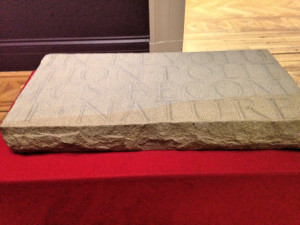A slogan is etched into a block of stone and the stone laid on a piece of red felt. There is something somewhat reverent about this inscription; the words carry weight and are to be handled with care.
You read the title off the block. And then you read it in a different way off the plaque on the wall. Just as you would read it in a different way again, if sprayed on brickwork. It’s unstable stone.
We all have our own reading. It’s the word nature which divides the audience. Is it human nature, as the Latinate letters imply? Or is it nature ‘red in tooth and claw’ as suggested by the crimson felt?
Perhaps it is even ‘second’ nature. It is as if, after the revolution, it will become habitual to think in political terms. It is as if it would take a revolution, not an election, to wake us all up in that way.
Finlay was a poet before he was an artist. Hence the gift for ambiguity. But the plastic elements in this work only add to the secrecy of his meaning. The poet is washing his hands of your response.
But the classical lettering must tell us something. At the very least it tells us that Finlay intends for his words to be around for millennia. To a blogger such as myself, that’s frankly scary.
The five terse words have been cut by his frequent collaborator Nicholas Sloan. A classical typeface suggests classical values. Social revolution was surely never among the values of Rome.
But the line is broken in three places. The tablet can barely contain the message. And so the artist’s sentiment, be it warning or promise, threatens to break free. As do we all from time to time.
Felt is a curious choice of material, more associated with the Asiatic barbarians at the gate. Or with Jospeh Beuys, another sloganeer. Beuys made a great deal of the healing properties of felt.
So as to revolution? You can’t make an omelette without breaking eggs, or even stones. But perhaps you can mop up the blood. And to say as much is as natural as it is political.
This piece can be seen at Manchester Art Gallery.
